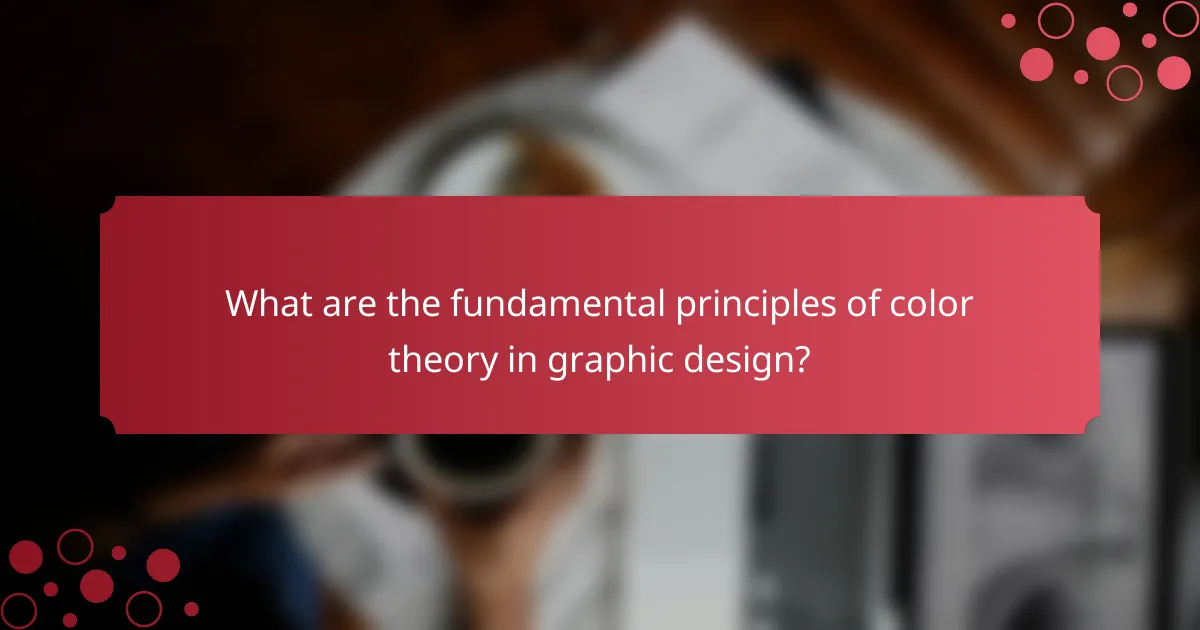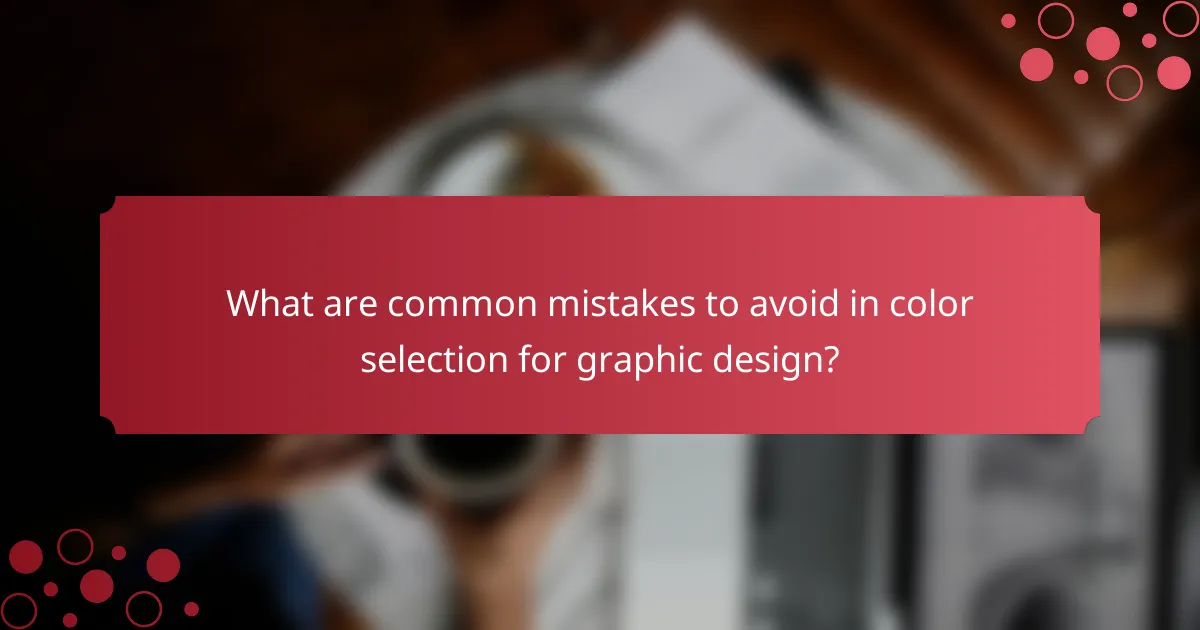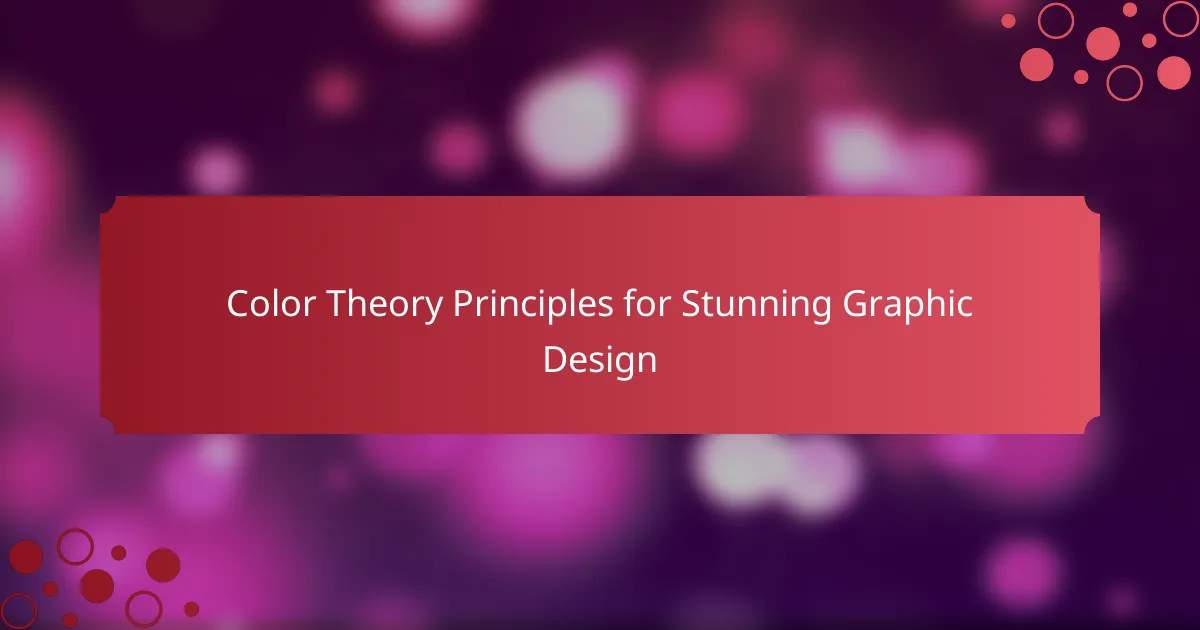Color theory principles are essential in graphic design, encompassing concepts such as the color wheel, color harmony, and color context. The color wheel organizes colors to illustrate their relationships, while color harmony focuses on creating aesthetically pleasing combinations. Color context explores how colors interact and are perceived based on their environment. Understanding these principles enhances design effectiveness, influencing emotional responses and viewer engagement. Additionally, the article addresses common mistakes in color selection, including excessive color use, inadequate contrast, and neglecting accessibility, which can undermine a design’s impact and clarity.

What are the fundamental principles of color theory in graphic design?
The fundamental principles of color theory in graphic design include the color wheel, color harmony, and color context. The color wheel is a visual representation of colors organized around a circle. It helps designers understand relationships between colors. Color harmony refers to aesthetically pleasing combinations of colors. This principle guides designers in creating visually appealing designs. Color context examines how colors interact with each other. It influences how colors are perceived based on their surroundings. Understanding these principles enhances design effectiveness. Studies show that color impacts emotions and behavior, reinforcing the importance of these principles in graphic design.
How do colors influence emotions and perceptions in design?
Colors significantly influence emotions and perceptions in design. Different colors evoke specific feelings and reactions. For example, red often signifies passion or urgency. Blue typically conveys trust and calmness. Yellow can evoke happiness and energy. Green is associated with nature and tranquility.
Research indicates that color can affect consumer behavior. A study by Satyendra Singh published in “Management Decision” found that color increases brand recognition by up to 80%. Additionally, colors can impact decision-making processes. The emotional response to colors is often immediate and subconscious.
Understanding color psychology is essential for effective design. Designers can use this knowledge to create desired emotional responses. By strategically selecting colors, they can enhance user experience and engagement.
What psychological effects do different colors have?
Different colors evoke specific psychological effects. For instance, red can stimulate energy and passion. It is often associated with excitement and urgency. Blue tends to promote calmness and stability. Studies show it can lower heart rates and reduce stress. Yellow is linked to happiness and optimism. It can enhance mood and stimulate mental activity. Green represents nature and tranquility. It is known to promote relaxation and balance. Purple often symbolizes creativity and luxury. It can inspire imagination and [censured]. Each color’s psychological impact can influence design choices in graphic design.
How can color choices affect brand identity?
Color choices significantly influence brand identity. Colors evoke emotions and perceptions that shape consumer attitudes. For instance, blue often conveys trust, while red can evoke excitement. Research shows that 85% of consumers make purchase decisions based on color. This highlights the importance of aligning color with brand values. Consistent color use enhances brand recognition by 80%. Therefore, effective color selection is crucial for establishing a strong brand identity.
Why is the color wheel important for graphic design?
The color wheel is important for graphic design because it visually represents relationships between colors. It helps designers understand color harmony and contrast. By using the color wheel, designers can create visually appealing compositions. The wheel illustrates primary, secondary, and tertiary colors. This categorization aids in choosing color schemes effectively. Color schemes like complementary and analogous can be easily identified. Studies show that color choices impact viewer perception and emotions. Therefore, the color wheel is a fundamental tool in effective graphic design.
What are the primary, secondary, and tertiary colors?
Primary colors are red, blue, and yellow. These colors cannot be created by mixing other colors. Secondary colors are green, orange, and purple. They are formed by mixing two primary colors. Tertiary colors are yellow-orange, red-orange, red-purple, blue-purple, blue-green, and yellow-green. These colors result from mixing a primary color with a secondary color. Understanding these color categories is essential in graphic design. They help create visually appealing and harmonious designs.
How do complementary and analogous colors work together?
Complementary and analogous colors work together by creating visual harmony and contrast. Complementary colors are opposite each other on the color wheel. They enhance each other’s intensity when placed side by side. This contrast draws attention and creates a vibrant look. Analogous colors are next to each other on the color wheel. They blend well and create a serene and comfortable design. Using both together can balance vibrancy with harmony. For example, pairing blue (complementary to orange) with green (analogous to blue) creates a dynamic yet cohesive palette. This technique is widely used in graphic design to attract and maintain viewer interest.

How can color theory enhance visual hierarchy in design?
Color theory enhances visual hierarchy in design by using color to guide viewer attention. Different colors evoke specific emotions and perceptions. For instance, warm colors like red and orange can draw attention, while cool colors like blue can recede. This allows designers to prioritize elements effectively. High contrast between colors can create focal points, making important information stand out. Research indicates that color combinations can significantly influence readability and user engagement. A study by the University of Alberta found that color can improve recall and recognition in visual tasks. Thus, applying color theory strategically can strengthen the overall effectiveness of design.
What role does contrast play in effective graphic design?
Contrast is essential in effective graphic design as it enhances visual hierarchy and readability. It helps to distinguish different elements, making important information stand out. High contrast between text and background increases legibility, facilitating easier reading. For instance, black text on a white background is a classic example of effective contrast. Additionally, contrast can evoke emotions and direct attention to focal points. The use of contrasting colors can create visual interest and dynamic compositions. According to a study by the Nielsen Norman Group, proper contrast improves user experience by making interfaces easier to navigate. Thus, contrast is a fundamental principle in graphic design that significantly impacts effectiveness.
How can contrast be achieved through color selection?
Contrast can be achieved through color selection by using colors that are opposite on the color wheel. This method is known as complementary color pairing. For example, pairing blue with orange creates a strong visual contrast. Additionally, varying the brightness and saturation of colors can enhance contrast. A bright yellow against a deep purple also exemplifies this principle. High contrast improves readability and draws attention to key design elements. Research indicates that effective contrast enhances user engagement in graphic design. Therefore, strategic color selection is essential for creating impactful visuals.
What are examples of high and low contrast designs?
High contrast designs use colors that are significantly different in hue or brightness. Examples include black text on a white background or bright red elements on a dark blue backdrop. These combinations enhance readability and draw attention.
Low contrast designs feature colors that are similar in hue or brightness. Examples include light gray text on a white background or pastel colors that blend together. These designs can create a softer, more subtle appearance but may reduce readability.
How does color harmony contribute to cohesive designs?
Color harmony contributes to cohesive designs by creating visual balance and unity. It ensures that colors work together effectively, enhancing the overall aesthetic. Harmonious color combinations evoke specific emotions and responses from viewers. For example, complementary colors create contrast while maintaining balance. Analogous colors provide a sense of tranquility and cohesiveness. Research shows that designs with color harmony are more appealing and engaging. A study published in the Journal of Experimental Psychology found that harmonious color schemes improve viewer satisfaction. This reinforces the importance of color harmony in creating effective graphic designs.
What are the different types of color harmonies?
The different types of color harmonies include complementary, analogous, triadic, tetradic, and monochromatic. Complementary color harmony uses colors opposite each other on the color wheel. This creates high contrast and vibrant visuals. Analogous harmony features colors next to each other on the wheel. It offers a more serene and comfortable effect. Triadic harmony involves three colors evenly spaced around the color wheel. This combination provides a balanced and dynamic look. Tetradic harmony consists of two complementary color pairs. It allows for rich color variations and contrasts. Monochromatic harmony utilizes variations in lightness and saturation of a single color. This results in a cohesive and unified design. Each type of color harmony serves distinct purposes in graphic design.
How can designers create harmony using color theory?
Designers can create harmony using color theory by employing complementary, analogous, or triadic color schemes. Complementary colors are opposite each other on the color wheel, creating high contrast and vibrancy. This contrast can enhance visual interest while maintaining balance. Analogous colors are next to each other on the wheel, producing a serene and comfortable design. This approach fosters a cohesive look. Triadic schemes involve three evenly spaced colors on the wheel, providing a dynamic yet balanced palette. Each scheme emphasizes different aspects of harmony, allowing designers to evoke specific emotions and responses. Research indicates that color harmony can significantly impact viewer perception and engagement, as supported by studies in color psychology.

What are common mistakes to avoid in color selection for graphic design?
Common mistakes to avoid in color selection for graphic design include using too many colors, which can create visual clutter. Inadequate contrast between text and background colors can lead to poor readability. Ignoring color psychology can result in miscommunication of the intended message. Failing to consider accessibility may alienate users with color vision deficiencies. Not testing color combinations in different lighting conditions can affect how colors appear. Over-reliance on trendy colors can date a design quickly. Lastly, neglecting the brand’s color palette can weaken brand identity.
What pitfalls should designers be aware of when using color?
Designers should be aware of several pitfalls when using color. One major pitfall is poor contrast, which can make text difficult to read. Insufficient contrast between background and foreground colors can hinder accessibility. Another pitfall is overuse of color, which can lead to visual clutter. This can distract viewers and dilute the intended message. Additionally, designers often overlook color psychology. Different colors evoke distinct emotions and associations. Ignoring these can result in miscommunication of the brand’s message. Designers may also struggle with color harmony. Using clashing colors can create a jarring visual experience. Lastly, not considering cultural differences in color perception can lead to misunderstandings. Colors can have different meanings across cultures, impacting the design’s effectiveness.
How can over-saturation affect a design’s effectiveness?
Over-saturation can diminish a design’s effectiveness by overwhelming viewers. High levels of color saturation can create visual fatigue. This fatigue makes it difficult for the audience to focus on key elements. Research indicates that designs with balanced saturation enhance readability and user engagement. For example, a study by the University of Reading found that overly saturated colors can lead to decreased comprehension. In contrast, designs using a harmonious color palette improve aesthetic appeal. Therefore, maintaining appropriate saturation levels is crucial for effective visual communication.
What are the consequences of poor color combinations?
Poor color combinations can lead to negative visual impact. They may cause confusion and distraction for viewers. In graphic design, this can hinder communication of the intended message. Poor color choices can also evoke undesirable emotions. For example, clashing colors can create feelings of discomfort. Research indicates that color harmony affects user experience significantly. A study by the University of Washington found that color contrast influences readability. Effective color combinations enhance engagement and retention of information. Therefore, poor combinations can result in decreased audience interest and effectiveness.
What practical tips can enhance color application in design?
Use a color wheel to identify complementary colors. This enhances visual contrast. Choose a limited color palette for cohesion. A palette of three to five colors creates harmony. Utilize the 60-30-10 rule for balanced color distribution. This rule suggests using 60% dominant color, 30% secondary, and 10% accent. Consider color psychology to evoke specific emotions. For example, blue conveys trust, while red evokes excitement. Test colors in different lighting conditions. Colors appear differently under various lights. Use tools like Adobe Color for digital design assistance. These tools help visualize color combinations effectively.
How can designers test color combinations effectively?
Designers can test color combinations effectively by using color contrast tools and mockups. Color contrast tools help evaluate the visibility and legibility of text against backgrounds. Designers can utilize online resources like Adobe Color and Coolors to generate and assess palettes. Creating mockups allows designers to visualize color combinations in context. This method helps identify how colors interact in real-world applications. Additionally, gathering feedback from users can provide insights into the effectiveness of color combinations. Research indicates that well-tested color combinations enhance user experience and engagement.
What tools are available for selecting and experimenting with colors?
Color selection and experimentation tools include color wheels, palettes, and software applications. Color wheels help visualize color relationships and combinations. Palettes allow users to create and save color combinations. Software applications like Adobe Color, Canva, and Coolors offer advanced features for color selection. These tools enable designers to explore various shades, tones, and contrasts. They also provide options for accessibility considerations. Many of these tools are free or have trial versions available. This accessibility encourages experimentation and creativity in graphic design.
The main entity of the article is “Color Theory Principles” in the context of graphic design. The article outlines fundamental principles such as the color wheel, color harmony, and color context, explaining how they contribute to effective design. It discusses the emotional and psychological effects of colors, the impact of color choices on brand identity, and the importance of contrast and harmony in visual hierarchy. Additionally, common mistakes in color selection and practical tips for enhancing color application are provided, along with tools for testing and experimenting with color combinations.
